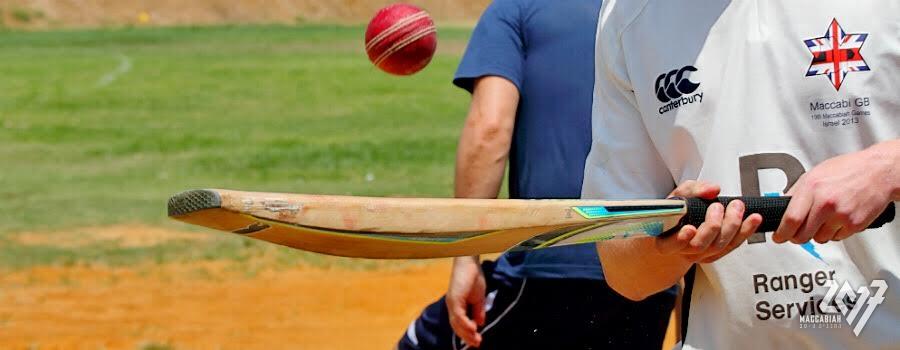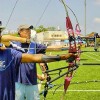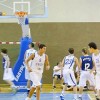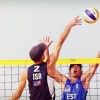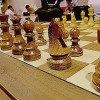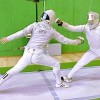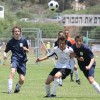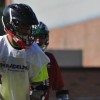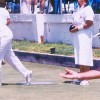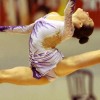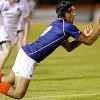Cricket
CRICKET REGULATIONS
Last Update 15/06/17
- Organization
- The Cricket Committee (CC) of the 20th Maccabiah will be responsible for the cricket competitions, both Open and Juniors, of the 20th Maccabiah.
- Each country may enter one squad only, of no more than 15 players, in each of the cricket competitions. A player not in possession of a valid Maccabiah Participation Card will not be permitted to participate in the cricket competition.
- The tournament will be played in keeping with the ICC Code of Conduct, with punishments modified to fit the Maccabiah Games. The Code of Conduct is attached as a separate document.
- The
Tournament Referee (TR) will receive results, scoresheets and all
relevant reports at the end of each match. The TR will deal with all
disciplinary issues up to Level 3.
- Venues and times
- System of competition
- The competitions will be played on a league basis with each team playing the other teams once.
- The teams finishing in 1st and 2nd places will play the Final to decide gold and silver medals, and teams finishing in 3rd and 4th places will play for bronze medal.
- Laws of Cricket
- The
Players
- Each captain is responsible for the submission of a team sheet consisting of 11 players (one of whom shall be captain) and 2 nominated 12th and 13th men to the umpires prior to the toss, including the age of the youth player. The team may not include a player not in possession of a valid Participant Card, as issued by the Organizing Committee of the 20th Maccabiah, unless special dispensation has been approved for that individual player.
- Team Uniforms are to be white. Any sponsorship to be approved by the CC prior to the Maccabiah.
- No metal spikes on footwear will be allowed on the pitch, while batting, bowling or keeping wicket.
- Substitutes
and runners
- If a fielder fails to take the field with his side at the start of the match or at any later time, or leaves the field during a session of play, the umpire shall be informed of the reason for his absence, and he shall not thereafter come on to the field during a session of play without consent of the umpire. The umpire shall give such consent as soon as practicable.
- If a player is absent from the field, either at the start or during the game, for longer than 8 minutes:
- The player shall not be permitted to bowl in that innings after his return until he has been on the field for at least that length of playing time for which he was absent.
- The player shall not be permitted to bat unless or until he has returned to the field and / or his sides innings has been in progress for at least that length of playing time for which he has been absent or, if earlier, when his side has lost five wickets.
The restrictions above shall not apply if the player has suffered an external blow (as opposed to an internal injury such as a pulled muscle) whilst participating earlier in the match and consequently been forced to leave the field. Nor shall it apply if the player has been absent for very exceptional and wholly acceptable reasons (other than injury or illness).
- A runner for an injured batsman will not be allowed.
- The Umpires and Scorers
The CC will appoint two official umpires in each match. A third umpire will be appointed where available. His duties are outlined in a separate document. Neither team will have a right of objection to an umpire’s appointment. The umpires shall be present at the ground at least 45 minutes before the scheduled start of play.
- Each team will be responsible for providing its own scorer.
- The Ball
Two new 4-piece full size balls will be supplied by the CC for each match. Only balls supplied by the CC will be permitted to be used. In the event of a ball being lost or becoming unplayable for continued use, the umpires will choose a replacement ball from a supply available at each venue.
- Innings
- Uninterrupted
Matches
- All matches shall be of one day’s scheduled duration. The matches will consist of one innings per side and each innings will be limited to 50 overs (Open) and 40 overs (Youth).
- Teams are allocated 3 hours and 35 minutes to complete their 50 overs (Open) and 2 hours and 55 minutes to complete their 40 overs (Junior) including the 3 drinks intervals of 5 minutes each.
- Should the team bowling first fail to complete their overs within the required time, the allotted overs will be completed but they will be limited to bat to the same number of overs they completed by the scheduled time for cessation of the first innings. If, in the opinion of the umpires, there are external factors preventing the completion of the allotted overs in the allocated time schedule (injury, extreme heat, loss of ball etc.) they have the power to extend the allocated time.
- Should the team bowling second not complete their allotted overs within the required time, the allotted overs will be completed but 6 runs for every over not completed within the scheduled time will be added to the score of the team batting second. The umpire will inform the fielding captain and the scorers before the over/s are bowled. If, in the opinion the umpires, there are external factors preventing the completion of the allotted overs in the allocated time schedule (injury, extreme heat, loss of ball etc.) they have the power to extend the allocated time and not award the penalty runs.
- The start of the over within allocated time shall be considered as an over within the allocated time.
- Delayed
or Interrupted Matches
- The object shall always be to rearrange the number of overs so that both teams have the opportunity of batting for the same number of overs.
- A minimum of 20 overs must be played by both teams in order to constitute a match.
- The number of overs to be played will only be reduced after an initial 60 minutes loss of playing time.
- The calculation of the number of overs to be reduced shall be based on an average rate of 15 overs per hour (1 over for every 4 minutes playing time lost).
- Interruption or delay to the innings of the team batting first
If the number of overs of the team batting first is reduced, a fixed time will be specified for the completion of the first session, as calculated by applying the provisions of clause b.
- Interruption or delay to the innings of the team batting second
If there is a suspension in play during the innings of the team batting second, the number of overs will be reduced, as calculated by applying the provisions of clause b. (A result will be determined in accordance with Clause 14b below)
- Number
of overs per bowler
- No bowler shall bowl more than 10 overs (Open) / 8 overs (Youth) in an innings.
- In a delayed or interrupted match where the overs are reduced for both teams or for the team bowling second, no bowler may bowl more than one-fifth of the total overs allowed.
- The Follow-on
Law 13 shall not apply. There will be no follow – on.
- Declaration and Forfeiture
Law 14 shall not apply. Declarations or forfeitures are not permitted.
- Intervals
- An interval will be taken between innings and will last 45 minutes.
- Intervals
for Drinks
- Three 5-minute drinks intervals shall be taken after the 13th, 25th, and 37th over of each innings (Open) / 10th, 20th, 30th (Youth). Drinks will be taken on the field of play.
- Under conditions of extreme heat the umpires may permit extra intervals for drinks.
- Any individual player may be given a drink either on the boundary edge or at the fall of a wicket, on the field, provided that no playing time is wasted.
- No drinks will be taken onto the field of play without the permission of the umpires.
- Start
of Play; Cessation OF PLAY
- Hours of Play (Youth in brackets):
First Session: 10:30 – 14:05 (10:30 – 13:25)
Lunch Interval: 14:05 – 14:50 (13:25 – 14:10)
Second Session: 14:50 – 18: 25 (14:10 – 17:05)
Unless otherwise stated on playing schedule.
- The
toss will be conducted on the field of play, in the presence of the
match umpire(s), 20 minutes prior to the scheduled start of play.
The captain winning the toss must declare immediately his
intentions, to Bat or Field.
- Any team not in position to start play 60 minutes after the scheduled start automatically loses the toss. The team responsible for the delayed start will be penalized 1 over from their batting allocation for every 4 minutes lost. Teams can be disciplined in accordance with Clause 19 for failure to compete in a scheduled match.
- In the event of the first innings being completed more than 1 hour before the schedule lunch interval, there shall be a 10-minute break between innings, the second innings shall commence and lunch will be taken at the original scheduled time.
- If the first innings is completed within 1 hour of the scheduled lunch break, lunch shall be taken at the completion of the innings and the second innings will commence thereafter.
- The Result
1. Win with Bonus ---------------- 5 points.
Win-------------------------------4 points.
Tie or No Result ----------------2 points.
Loss ------------------------------0 point.
2.
- In a match in whom both teams have had an opportunity of batting for an equal number of overs, the team scoring the most runs shall be the winner. If the scores are equal the match will be declared a tie, regardless of the number of wickets lost by either team or any other factors.
- In the event of the number of overs of the team batting second being reduced (see Clause 9 above), the target will be set according to the run rate achieved by the team batting first +1 run.
Example: The team batting first completes their innings.
A suspension in play reduces the number of overs available to the team batting second to 35 overs. The target score will be the first innings score divided by 50 (full quota of overs), multiplied by 35 + 1 run. In calculating the run rate, any fractions will be ignored.
- In
the event that both teams are unable to bat for at least 20 overs,
the game will be declared a “No Result”.
- Net
Run Rate
- A team’s net run rate is calculated by deducting from the average runs per over scored by that team throughout the competition, the average runs per over scored against that team throughout the competition.
- In the event of a team being all out in less than its full quota of overs, the calculation of its net run rate shall be based on the full quota of overs to which it would have been entitled and not on the number of overs in which the team was dismissed.
- Only those matches in whom a result was possible will count for the purpose of net run rate.
- Dead Ball
Law 23 shall apply subject to the following:
- A ball which hits the edge of the matting or the nails which holds the matting in place and brings the batsman into a disadvantaged position shall be deemed a dead ball and the ball shall be re-bowled.
- A ball which hits the edge of the matting or the nails which holds the matting in place but which does not bring the batsman into a disadvantaged position shall be deemed a wide.
- No Ball
Law 24 shall apply subject to the following:
- The bowler may not deliver the ball underarm. Such a delivery will be called a “No Ball”.
- If the ball passes or would have passed above the shoulder height of a batsman standing upright at the crease, the umpire at the bowler's end shall call and signal “No Ball”.
- If the ball passes or would have passed on the full above the waste height of a batsman standing upright at the crease, the umpire at the bowlers end shall call and signal “No Ball”.
- Any ball pitched off the matting shall be called a “No Ball”.
- Bowler breaking wicket in delivering ball.
Either umpire shall call and signal No ball if, other than in an attempt to run out the non-striker Under Clause 42.11, the bowler breaks the wicket at any time after the ball comes into play and before he completes the stride after the delivery stride.
For the purpose of this clause, the amended definition of delivery stride from Appendix D - Laws of Cricket shall apply:
Delivery Stride is the stride during which the delivery swing is made, whether the ball is released or not. It starts when the bowler’s back foot lands for that stride and ends when the front foot lands in the same stride. The “stride after the delivery stride” is completed when the next foot lands i.e., when the back foot of the delivery strides lands again.
- Free Hit after any kind of no ball
In addition to the above, the delivery following a no ball shall be a free hit for whichever batsman is facing it. If the delivery for the free hit is not a legitimate delivery (any kind of no ball or a wide ball) then the next delivery will become a free hit for whichever batsman is facing it.
For any free hit, the striker can be dismissed only under the circumstances that apply for a no ball, even if the delivery for the free hit is called wide ball.
Field changes are not permitted for free hit deliveries unless there is a change of striker (the provisions of clause 41.2 shall apply).
The umpires will signal a free hit by (after the normal No Ball signal) extending one arm straight upwards and moving it in a circular motion.
- A penalty of one run for a No ball shall be scored. This penalty shall stand in addition to any other runs which are scored or awarded.
- Dangerous
and Unfair Bowling
- The
Bowling of Fast Short Pitched Balls
- A bowler shall be limited to one fast short-pitched delivery per over.
- A fast short-pitched delivery is defined as a ball which passes or would have passed above the shoulder height of the striker standing upright at the popping crease.
- The umpire at the bowlers end shall advise the bowler and the batsman on strike when each fast short pitched delivery has been bowled.
- In the event of a bowler bowling more than one fast short-pitched delivery in an over, the umpire at the bowlers end shall call and signal no ball on each occasion. A differential signal shall be used to signify a fast short pitched delivery. The umpire shall call and signal ‘no ball’ and then tap the head with the other hand.
- If a bowler delivers a second fast short pitched ball in an over, the umpire, after the call of no ball and when the ball is dead, shall give the bowler a final warning, inform the other umpire, the captain of the fielding side and the batsmen at the wicket of what has occurred. This final warning shall apply throughout the innings.
- The umpires will then report the matter to the Tournament Referee who shall there be any further instance by the same bowler in that innings, the umpire shall call and signal no ball and when the ball is dead direct the captain to take the bowler off forthwith. If necessary, the over shall be completed by another bowler, who shall neither have bowled the previous over, or part thereof, nor be allowed to bowl the next over, or part thereof.
- The bowler thus taken off shall not be allowed to bowl again in that innings. Any part of unfinished over, will be considered as a full over of the bowler.
- The umpire will report the occurrence to the other umpire, the batsmen at the wicket and as soon as possible to the captain of the batting side.
- The umpires will then report the matter to the Match Referee who shall take such action as is considered appropriate against the captain and the bowler concerned. (Refer also to Law 42.1 Fair and Unfair Play - Responsibility of the Captains.)
- Bowling of High Full Pitched Balls
Law 42.6 (b) shall be replaced by the following:
- Any delivery, which passes or would have passed on the full above waist height of the striker standing upright at the popping crease is deemed unfair, whether or not it is likely to inflict physical injury on the striker.
- In the event of a bowler bowling a high full pitched ball, the umpire at the bowler’s end shall call and signal no ball.
If, in the opinion of the umpire, such a delivery is considered likely to inflict physical injury on the batsman, the umpire at the bowler’s end shall, in addition to calling and signaling no ball, when the ball is dead, caution the bowler and issue a first and final warning. The umpire shall inform the other umpire, the captain of the fielding side and the batsmen at the wicket of what has occurred.
- Should
there be any further instance (where a high full pitched ball is
bowled and is considered likely to inflict physical injury on the
batsman) by the same bowler in that innings, the umpire shall in
addition to calling and signaling no ball, when the ball is dead,
direct the captain to take the bowler off forthwith. If necessary,
the over shall be completed by another bowler, who shall neither
have bowled the previous over, or part thereof, nor be allowed to
bowl the next over, or part thereof.
- The bowler thus taken off shall not be allowed to bowl again in that innings. Any part of unfinished over will be considered as a full over of the bowler.
- The umpire will report the occurrence to the other umpire, the batsman at the wicket and as soon as possible to the captain of the batting side.
- The umpires will then report the matter to the tournament Referee who shall take such action as is considered appropriate against the captain and the bowler concerned. (Refer also to Law 42.1 Fair and Unfair Play - Responsibility of the Captains.)
- Dangerous and Unfair Bowling - Action by the umpire
Law 42.7 shall be replaced by the following:
Regardless of any action taken by the umpire as a result of a breach of Clauses 42.4. the following shall apply at any time during the match:
42.5 The bowling of fast short pitched balls is unfair if in the opinion of the umpire at the bowler’s end he considers that by their repetition and taking into account their length, height and direction, they are likely to inflict physical injury on the striker, irrespective of the protective clothing and equipment he may be wearing. The relative skill of the striker shall also be taken into consideration.
In the event of such unfair bowling, the umpire at the bowler’s end shall adopt the following procedure:
- In the first instance the umpire shall call and signal no ball, give the bowler a final warning and inform the other umpire, the captain of the fielding side and the batsmen of what has occurred.
- The final warning shall continue to apply even though the bowler may later change ends.
- Should there be any further instance by the same bowler in that innings, the umpire shall call and signal no ball and when the ball is dead direct the captain to take the bowler off forthwith. If necessary, the over shall be completed by another bowler, who shall neither have bowled the previous over, or part thereof, nor be allowed to bowl the next over, or part thereof. Any part of unfinished over will be considered as a full over of the bowler.
- The bowler thus taken off shall not be able to bowl again in that innings.
- The umpire will report the occurrence to the other umpire, the batsmen at the wicket and as soon as possible to the captain of the batting side.
- The umpires will then report the matter to the tournament Referee who shall take such action as is considered appropriate against the captain and the bowler concerned. (Refer also to Law 42.1 Fair and Unfair Play - Responsibility of the Captains.)
42.6 Law 42.8 - Deliberate bowling of High Full Pitched Balls
Law 42.8 shall be replaced by the following:
If the umpire considers that a high full pitch delivery which is deemed unfair as defined in Clause 42.4 was deliberately bowled, then the caution and warning process shall be dispensed with.
The umpire at the bowler’s end shall:
42.6 Call and signal no ball.
42.7 When the ball is dead, direct the captain to take the bowler off forthwith.
42.7 Not allow the bowler to bowl again in that innings.
42.7 Ensure that the over is completed by another bowler, provided that the bowler does not bowl two overs or part thereof consecutively.
42.7 Report the occurrence to the other umpire, to the captain of the batting side and the Match Referee who shall take such action as is considered appropriate against the captain and the bowler concerned. (Refer also to Law 42.1 Fair and Unfair Play Responsibility of the Captains).
42.7 Action by the umpires for dangerous and unfair Bowling.
- Wide Ball
Law 25 shall apply subject to the following –
- Umpires are instructed to apply consistent interpretation in regard to this Law in order to prevent negative bowling wide of the wicket.
- Any
offside or leg side delivery which in the opinion of the umpire does
not give the batsman a reasonable opportunity to score shall
be called a “wide”.
- A penalty of one run for a wide shall be scored. This penalty shall stand in addition to any other runs which are scored or awarded. All runs, which are run or result from a wide ball, which is not a no ball, shall be scored as wide balls.
- In accordance with clause 15.1b) above, a ball which hits the edge of the matting or the nails which holds the matting in place but which does not bring the batsman into a disadvantaged position shall be deemed a wide.
- Restrictions
on the Placement of Fielders and Protective Equipment
- Protective Equipment
The following shall apply in addition to Law 41.1:
The exchanging of protective equipment between members of the fielding side on the field shall be permitted provided that the umpires do not consider that it constitutes a waste of playing time.
- Restrictions
on the Placement of Fieldsmen
- At the instant of delivery, there may not be more than 5 fieldsmen on the leg side.
- In addition to the restriction contained in clause 41.2.1 above, further fielding restrictions shall apply to certain overs in each innings. The nature of such fielding restrictions and the overs during which they shall apply (hereinafter referred to as the Powerplay Overs) are set out in the following paragraphs.
- The following fielding restrictions shall apply:circles shall be drawn on the fiel The radius of each of the semi-circles shall be 30 yards (27.43 meters). The semi-circles shall be linked by two parallel straight lines drawn on the field. (Refer attached Appendix 5). The fielding restriction areas should be marked by continuous painted white lines or ‘dots’ at 5 yard (4.57 meters) intervals, each ‘dot’ to be covered by a white plastic or rubber (but not metal) disc measuring 7 inches (18 cm) in diameter.
During the first block of Powerplay of 10 Overs (as set out below), only two fieldsmen shall be permitted outside this fielding restriction area at the instant of delivery.
During the second block of Powerplay (during 11- 40 Overs) max' 4 fieldsmen shall be permitted outside this fielding restriction area at the instant of delivery.
During the third block of Powerplay (during 41- 50 Overs)
Max' 5 fieldsmen shall be permitted outside this fielding restriction area at the instant of delivery.
- In
circumstances when the number of overs of the batting team is
reduced, the number of Powerplay Overs shall be reduced in
accordance with the table below. For the sake of clarity, it should
be noted that the table shall apply to both the
- Each block of Powerplay Overs must commence at the start of an over.
Innings duration
First
Powerplay
Second Powerplay
Third Power Play
20
4
12
4
21
4
13
4
22
5
13
4
23
5
14
4
24
5
14
5
25
5
15
5
26
5
16
5
27
6
16
5
28
6
17
5
29
6
17
6
30
6
18
6
31
6
19
6
32
7
19
6
33
7
20
6
34
7
20
7
35
7
21
7
36
7
22
7
37
8
22
7
38
8
23
7
39
8
23
8
40
8
24
8
41
8
25
8
42
9
25
8
43
9
26
8
44
9
26
9
45
9
27
9
46
9
28
9
47
10
28
9
48
10
29
9
49
10
29
10
- If play is interrupted at the start of the game or during the game , and the overs are reduced, in this case the Power Play shall take place according to the above table.
f. If play is interrupted during the first Powerplay and on resumption the overs required to be bowled in that Powerplay have already been exceeded, then the second Powerplay will be assumed to have been taken immediately and will continue until it is completed, according to the above table.
A 50 over innings is interrupted after 9.3 overs, and on resumption has been reduced to 43 overs. Powerplay overs are 9+26+8, and on resumption should be the start of the 2nd Powerplay .
- At
the commencement of the second block of Powerplay Overs, the umpire
shall signal such commencement to the scorers by rotating his arm in
a large circle.
- In the event of an infringement of any of the above fielding restrictions, the square leg umpire shall call and signal ‘No Ball’
- Misconduct of a Player, Team, Umpire or Official– Discipline and Penalties The Tournament Referee (TR) has full power to deal with misconduct by a team, official, umpire or player during the course of any game, or within 30 minutes of its start or completion. The accused party shall have the opportunity to defend an allegation and may be accompanied by his representative. The TR will act in accordance with the Maccabiah disciplinary guidelines which will be distributed to each team upon request. The TR has the right to impose match suspensions, point deductions, monetary fines or any other penalties it deems fit in the circumstances
– Offence Level 1,2,3 Please refer to the attached document for the 20th Maccabiah Cricket Tournament.
Forfeiture of any game will be considered misconduct.
Offence Level 4 will be dealt with by the 20th Maccabiah Court of Discipline.
- Special
Regulations (Youth Players)
- Fielding, Bowling and Batting Directives
The overriding desire of the CC is to ensure the health and safety of all its players and these regulations have been adopted with that desire expressly in mind. It must be noted that the regulations are aimed at an individual’s age as opposed to the age group of the tournament being played. For example, a player who is aged 15 must abide by the restrictions laid down for that age group. This will apply even though he may be playing in an U18 match. He cannot bowl/field using the U18 restrictions – he is still bound by the U15 restrictions.
Fielders:
- No young player aged 15 or younger shall be allowed to field closer than 8 yards (7.3 metres) from the middle stump, except behind the wicket on the off side, until the batsman has played at the ball.
- Players aged 13 and younger the distance is 11 yards (10 metres).
- Minimum distances apply even if the player is wearing a helmet.
- Should a young player in these age groups come within the restricted distance the umpire must stop the game immediately and instruct the fielder to move back.
- In addition any young player aged 16 - 18, who has not reached the age of 18, must wear a helmet and, for boys, an abdominal protector (box) when fielding within 6 yards (5.5 meters) of the bat, except behind the wicket on the off side. Players should wear appropriate protective equipment whenever they are fielding in a position where they feel at risk.
Wicket-keepers:
- Wicket-keeper under the age of 18 (on the day of the match) must wear a helmet when standing up to the stumps.
- This applies for all speeds of bowling.
- Non-compliance with this Directive will result in the umpires immediately stopping the game and instructing the wicket-keeper to put on a helmet, or stand back from the stumps.
- Bowling Restrictions
For the purpose of these Directives a fast bowler should be defined as a bowler to whom a wicket keeper in the same age group would, in normal circumstances, stand back to take the ball. This does not preclude the umpires from insisting that these Directives are applied even though the ability of the wicket-keeper means that he is capable of standing up to what they consider to be a fast bowler. All coaches are urged to identify those players with the potential to bowl fast and to ensure they follow the Directives in all cricket throughout the season.
Over bowling is an important consideration, especially for young bowlers whose bodies are not fully developed. Recent studies have revealed that over bowling is the most common cause of back injuries. Evidence suggests that much of the damage occurs early in the playing career, and especially during growth spurts, though the effects do not often show themselves until the late teens. The more talented and more physically mature youngsters are generally most at risk, as they tend to play at more than one age group level. To ensure that young fast bowlers do not place undue stress on their bodies, every attempt must be made to keep the amount of bowling within reasonable limits. The following Directives provide sensible playing levels.
- Directive for matches
Age Max overs per spell Max overs per day
Up to 13 4 overs per spell 8 overs per day
14, 15 5 overs per spell 10 overs per day
16, 17 6 overs per spell 10 overs per day
18, 19 7 overs per spell 10 overs per day
Having completed a spell the bowler cannot bowl again, from either end, until the equivalent number of overs to the length of his spell has been bowled from the same end. If the bowler only completes part of his permitted spell then the above restriction still applies. For example, if he is allowed 7 overs but only bowls 4, he cannot bowl again until 4 overs have been bowled from the same end. He cannot resume his ‘spell’ after 2 further overs, from the same end, claiming that he is allowed another 3 to make up his 7. However, a bowler is allowed to change ends during a spell without having to take a rest. This can only be done provided that he bowls the next permissible over from the other end. Any wait over and above this will mean that the current spell has ended and the rest period will be enforced. The second part of this spell will be restricted to the remainder of the overs allowed under the table above. If a bowler is ‘resting’ and there is an interruption in play, whether scheduled or not, he will be allowed to count time off the field as part of his ‘rest time’. During this interruption the bowler may count every 7 minutes of the interruption as being equivalent to 1 over at each end.
- Interruption of play during a spell of bowling
If play is interrupted, for any reason, for less than 40 minutes, any spell in progress at the time of the interruption can be continued after the interruption up to the maximum number of overs per spell for the appropriate age group. (In this case the bowler cannot claim any time off the field as rest time and his ‘spell’ will still be in progress even though play is suspended.) If the spell is not continued after the interruption the bowler cannot bowl again, from either end, until the equivalent number of overs to the length of his spell before the interruption have been bowled from the same end. If the interruption is of 40 minutes or more, whether scheduled or not, the bowler can commence a new spell immediately.
Once a bowler covered by these Directives has bowled in a match he cannot exceed the maximum number overs per day for his age group even if he subsequently bowls spin. He can exceed the maximum overs per spell if bowling spin only, but cannot then revert to bowling fast until an equivalent number of overs to the length of his spell have been bowled from the same end. Any spell that includes fast bowling must not exceed the maximum number of overs per spell even if some of the spell is of spin.
- Umpires’ responsibility
The umpires are expected to monitor these players and keep records of the overs such players bowl. Once the maximum allowance for any one spell has been reached they will inform the player and captain accordingly and will not allow that player to bowl again until the requisite rest period has been fulfilled.
Prior to the game the manager/coach/captain will inform the umpires, in writing, of any player who comes under this Directive. This will help the umpires to identify the players concerned. However, if the umpires consider that, during the game, other players come under this Directive they shall inform the CC and manager/coach/captain as soon as is practical, that these players will be subject to the above Directives.
- Batting Directive
Every batsman (both Senior and Junior) must wear a helmet when batting.
Non-compliance of this Directive will result in the umpires immediately stopping the game and instructing the batsman to put on a helmet.
- General
In the event of any dispute(s) regarding these Directives the CC will make the final arbitration. In order to comply with these Directives it is the responsibility of every participating team to ensure that the appropriately fitted helmets are available for every player in their team.
- Coaches and Managers not allowed on the field of play
Unless there is an unforeseen circumstance, such as an injury, Coaches, Managers and other Team Officials are not allowed onto the field of play during a match apart from drinks intervals at Youth games where coaches are allowed onto the field of play, along with the 12th Man who takes the drinks onto the field. The 12th man may also take out replacement equipment. Every time the 12th man enters the field of play he is required to be dressed in full cricket whites or appropriate team training kit.
- Forms
to be completed at the close of play
- Captain will complete the Umpires Evaluation Form
- Captain will complete a score sheet.
Both forms will be submitted to the third umpire or on field umpire if no umpire available. The non-submission of either form will be considered misconduct.
- Awards
- A Man of the Match award will be awarded at the completion of each match. The on field umpires together with the third umpire (if there is one) will decide the Man of the Match.
- A Player of the Tournament in both the Open and Youth tournaments will be determined by a special panel consisting of umpires and representatives of the CC.
- A special "Spirit of Cricket Award" will be awarded to an individual or team in both the Open and Youth tournaments, to be determined by a special panel consisting of umpires and representatives of the CC.
- General
These regulations are but one part of the complete 20th Maccabiah regulations, and must be read along with the instructions found in "Basic Rules and Regulations and Disciplinary Procedures".
- Bonus Points System
1 bonus point for any team that achieves victory with a run-rate 1.25 times that of the opposition.
A team's run-rate will be calculated by reference to the number of runs scored
divided by the number of overs.Where a side is all out, the numbers of overs to be used is the maximum
numbers of overs that side was otherwise eligible to face.
Where matches are shortened and targets revised through the
Duckworth/Lewis/Stern system, bonus run-rates and bonus defensive targets are
derived as a function of the revised target score (less 1 run) and maximum
overs.
Whenever a target, or revised target, is set, the exact number of overs/balls
within which the side batting second must achieve this target in order to gain
the bonus point should be announced. Once these overs/balls have been
bowled, if the target has not then been achieved the bonus point cannot be
gained by any subsequent event, eg a multiple scoring shot or extras.
Bonus points will be awarded only in matches in which the amount of overs are
equal in both innings.
Example:
Team Batting First
Team Batting Second
Team Fielding Second.
Scoreed 250 Runs for 50 overs.
Required R.R
5X1.25 = 6.25
Required R.R 5/1.25 = 4
Run Rate 250/50 = 5
250 Runs/6.25 =40 overs.
4x50 overs=200 Runs.
- The
Bowling of Fast Short Pitched Balls
- Net
Run Rate
- Uninterrupted
Matches
The Sport department of the 20th Maccabiah will determine the venues and times of the Cricket competitions and teams will be notified accordingly.
SYSTEM A: With the participation of 4 teams;
SYSTEM B: With the participation of 3 teams;
Each team will play the other twice in the group stage. The teams finishing in the top two places after the group stage will compete in a final.
SYSTEM C: With the participation of 5 or more teams;
Each team will play the other once in the group stage. At the conclusion of the group stage, the top two teams will meet in the Final, and the 3rd and 4th placed teams will play for the bronze medal.
Except as varied in the clauses hereunder the Laws of Cricket (2016 Code) shall apply. These laws shall apply for matches in both the Open and youth competitions.
PARTICIPATING COUNTRIES - Cricket
OPEN CRICKET : MALE
|
AUS |
|
GBR |
|
IND |
|
RSA |
|
ISR |
JUNIORS CRICKET : BOYS
|
AUS |
|
GBR |
|
RSA |
|
ISR |
The Games



